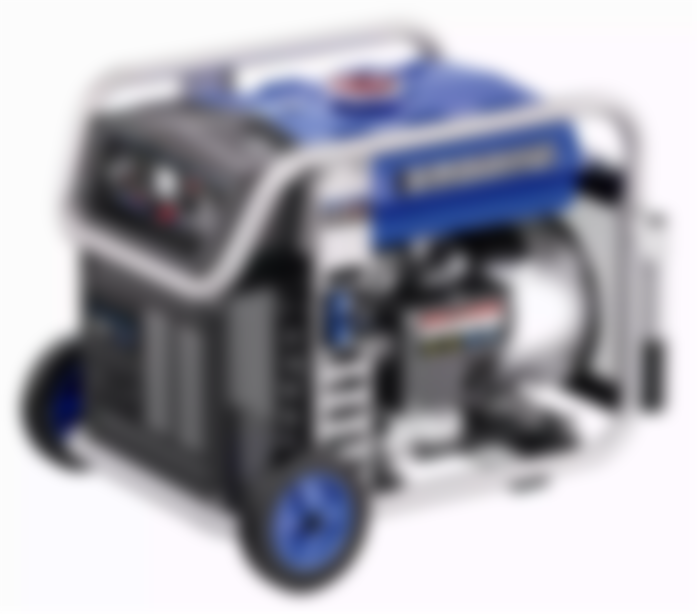WHAT IS A GENERATOR?

In electricity generation, generator is a device that converts mechanical energy obtained from an external source into electrical energy as the output.
Generators are useful appliances that supply electrical power during a power outage and prevent discontinuity of daily activities or disruption of business operations. Generators are available in different electrical and physical configurations for use in different applications.
It is important to understand that a generator does not actually ‘create’ electrical energy. Instead, it uses the mechanical energy supplied to it to force the movement of electric charges present in the wire of its windings through an external electric circuit. This flow of electric charges constitutes the output electric current supplied by the generator. This mechanism can be understood by considering the generator to be analogous to a water pump, which causes the flow of water but does not actually ‘create’ the water flowing through it.
WHAT IS A STANDBY GENERATOR?

A standby generator is a system that supplies backup power in the case of an outage by way of either natural gas or propane as a fuel source. They can come in a very wide array of sized, from systems that are capable of powering an entire home, to ones that just keep the lights on or the refrigerator running.
This is one kind of an electrical system, used to operate through an automatic transfer switch that gives a signal to power up a device in power loss. The best characteristics of a standby generator includes the following.
· The operation of this can be done automatically.
· It is used in safety systems for standby lighting, elevators, life support equipment, medical & fire protection systems.
· It provides stable power protection.
· It monitors utility power constantly.
· It executes self-tests automatically every week to check that it is responding properly or not to loss of power.
· It includes two components like an automatic transfer switch & a standby generator.
· It detects the loss of power in seconds & enhances electricity.
· It operates by using natural gas otherwise liquid propane.
WHAT ARE THE FACTORS TO BE CONSIDERED IN SELECTING A STANDBY GENERATOR?
The first thing to consider is safety and compliance as all electrical equipment and appliances only guarantee operation within specified tolerances or quality of supply; failing this results in either underperformance, failure or damage to equipment. Hence, standby generation must also guarantee and maintain operation within such equipment tolerances – for example, an approximate 5% variation in voltage and an approximate 1% variation in frequency. Failing this, electric motors might overheat or stall due to under-voltage.
Other not too obvious issues are those of safety and protection, as one does not have the downstream electrical protection that either Eskom or the municipality supplies. Hence, any faults experienced by the standby generator will have to be "cleared" by your own protection; otherwise the system will simply stall, creating your very own load shed or blackout.
To summarize, the following should be noted:
· Magnitude of voltage variation – rated approximately 5% (within 0,5 seconds).
· Magnitude of frequency variation – 50 Hz approximately 1% (within 5 seconds).
· Waveform quality <2% sinusoidal with <2% imbalance for three phase.
MAIN CLASSIFICATION OF ELECTRIC GENERATORS AND ITS PRINCIPLE OF OPERATION
Generators are classified into different types like portable, standby, inverter, industrial and induction generators.
Portable Generator

These are extremely used in different applications and these are available in different configurations by changing power. These are helpful in normal disasters once grid power damages. They are used in residential, slighter commercial establishments like shops, retail outlets, at construction field to provide power to smaller tools, outdoor weddings, camping, outdoor events & to provide supply to agricultural devices like bore wells otherwise drip irrigation systems.
This kind of generator is powered through diesel fuel otherwise gas to provide short-term electrical power. The main characteristics of the portable generator are:
- It conducts electricity by using a combustion engine.
- This can plug into different tools otherwise appliances through its sockets.
- It can be connected into subpanels.
- It is utilized in remote areas.
- It uses less power to operate the freezer, Tv, and refrigerator.
- The speed of the engine should be at 3600 rpm to make the typical current with a frequency of 60 hz of current.
- The engine speed can be controlled through the operator
- It provides power to lights as well as tools
Inverter Generator

This type of generator uses an engine by connecting it into an alternator for generating AC power, and also uses a rectifier to change the AC to DC power. These are used in refrigerators, air-conditioners, boat automobiles which require the values of specific frequency as well as voltage. These are available in less weighty & solid. The characteristics of this generator mainly include the following:
- It depends on modern magnets.
- It uses higher electronic circuits.
- It uses 3-phases for generating electricity.
- It maintains a stable current supply to a device.
- It is energy efficient because the speed of an engine will adjust itself based on the required power.
- When it is used with the proper device then its alternating current can be fixed to any voltage as well as frequency.
- These are lightweight and used in a car, boat, etc.
Standby Generator

This is one kind of an electrical system, used to operate through an automatic transfer switch that gives a signal to power up a device in power loss. The best characteristics of a standby generator include the following:
- The operation of this can be done automatically
- It is used in safety systems for standby lighting, elevators, life support equipment, medical & fire protection systems.
- It provides stable power protection
- It monitors utility power constantly
- It executes self-tests automatically every week to check that it is responding properly or not to loss of power.
- It includes two components like an automatic transfer switch & a standby generator
- It detects the loss of power in seconds & enhances electricity
- It operates by using natural gas otherwise liquid propane.
- It uses a combustion engine internally.
Industrial Generators

Industrial generators are something different as compared with commercial otherwise residential applications. These are robust & rugged that perform under harsh conditions. The power supply characteristics provide will range from 20 kW-2500 kW, 120-48 volt & 1- phase to 3-phase supply. Usually, these are more customized as compared with other types. The classification of these generators can be done based on the fuel used to make the engine run so that electric power can be generated. The fuels are natural gas, diesel, gasoline, propane, and kerosene.
Induction Generators

These generators are two types like self-excited and externally excited. Self-excited are used in windmills where the wind is used like a nontraditional energy source that converts to electrical energy. Externally excited are used in the applications of regenerative braking applications like cranes, hoists, electrical locomotives, and elevators.
Kinds of Electric Generator
MHD generator

A magneto-hydrodynamic generator directly extracts electric power from moving hot gases through a magnetic field, without the use of rotating electromagnetic machinery. MHD generators were originally developed because the output of a plasma MHD generator is a flame, well able to heat the boilers of a steam power plant. The first practical design was the AVCO Mk. 25, developed in 1965. The U.S. government funded substantial development, culminating in a 25Mw demonstration plant in 1987. MHD generators operated as a topping cycle are currently (2007) less efficient than combined-cycle gas turbines.
Excitation

A small early 1900s 75 KVA direct-driven power station AC alternator, with a separate belt-driven exciter generator. An electric generator or electric motor that uses field coils rather than permanent magnets will require a current flow to be present in the field coils for the device to be able to work. If the field coils are not powered, the rotor in a generator can spin without producing any usable electrical energy, while the rotor of a motor may not spin at all. Very large power station generators often utilize a separate smaller generator to excite the field coils of the larger. In the event of a severe widespread power outage where islanding of power stations has occurred, the stations may need to perform a black start to excite the fields of their largest generators, in order to restore customer power service.
Vehicle-mounted generators

Engine-generator

An engine-generator is the combination of an electrical generator and an engine (prime mover) mounted together to form a single piece of self-contained equipment. The engines used are usually piston engines, but gas turbines can also be used. Many different versions are available - ranging from very small portable petrol powered sets to large turbine installations.
HOW LONG IS THE AVERAGE GENERATOR RUN TIME?
Human powered electrical generators
Human powered electrical generators Main article: Self-powered equipment A generator can also be driven by human muscle power (for instance, in field radio station equipment). Human powered direct current generators are commercially available, and have been the project of some DIY enthusiasts. Typically operated by means of pedal power, a converted bicycle trainer, or a foot pump, such generators can be practically used to charge batteries as large as 12 volts, and in some cases are designed with an integral inverter. Portable radio receivers with a crank are made to reduce battery purchase requirements, see clockwork radio.
Rotating Electromagnetic Generators
Other rotating electromagnetic generators without a commutator, the dynamo is an example of an alternator, which is a synchronous singly-fed generator. With an electromechanical commutator, the dynamo is a classical direct current (DC) generator. The alternator must always operate at a constant speed that is precisely synchronized to the electrical frequency of the power grid for non-destructive operation. The DC generator can operate at any speed within mechanical limits but always outputs a direct current waveform. Other types of generators, such as the asynchronous or induction singly-fed generator, the doubly-fed generator, or the brushless wound-rotor doubly-fed generator, do not incorporate permanent magnets or field windings (i.e, electromagnets) that establish a constant magnetic field, and as a result, are seeing success in variable speed constant frequency applications, such as wind turbines or other renewable energy technologies. The full output performance of any generator can be optimized with electronic control but only the doubly-fed generators or the brushless wound-rotor doubly-fed generator incorporate electronic control with power ratings that are substantially less than the power output of the generator under control, which by itself offer cost, reliability and efficiency benefits.
Most portable generators will run on gasoline out of convenience. A standard 5,000 watt generator will consume around 18 gallons of gasoline during a 1 day/24 hour period. This makes it very unrealistic and expensive for long term use. This is why more and more are turning to inverter generators. Most of these offer an eco or economy mode which varies throttle (and ultimately fuel consumption) based on load demands. These are the most efficient gasoline generators. Usually one tank a fuel, which may only be 1-2 gallons, will last 8-10 hours. Therefore, running two inverter generators, which are usually 2,000-4,000 watt power source together, are usually more efficient than running a larger 5,000+ watt open frame generator. Again, this come back to the presence of economy mode as well as the technology/process that produces energy.
HOW MUCH FUEL DOES YOUR GAS GENERATOR HOLD?
Standby generator works with two major parts: it works with the generator itself and with a transfer switch. When the generator is engaged, it will consume fuel (gas or propane) to provide electrical power to your home. When the outage ends, the generator goes back into standby, and you resume the use of utility power.
It is a back-up electrical system that operates automatically. Within seconds of utility outage an automatic transfer switch senses the power loss, commands the generator to start and then transfers the electric load to the generator. The standby generator begins supplying power to the circuits. After utility power returns, the automatic transfer switch transfers the electrical load back to the utility and signals the standby generator to shut off. It then returns to standby mode where it awaits the next outage.
You may wonder why my article for tonight is like this. Actually, this was my output for our Working Paper 9 and I just wanted to share this to you. I hope you had fun reading and learned something. Have a great night!

For the classification and kinds of generator, click the image for their respective sources.
Other sources:
GREGORY DIANA, DEPARTMENT OF ELECTRICAL AND ELECTRONIC ENGINEERING, UNIVERSITY OF KWAZULU-NATAL AND THE SOUTH AFRICAN INSTITUTE OF AGRICULTURAL ENGINEERS (SAIAE)
Online websites:
https://www.generatorsource.com/How_Generators_Work .aspx
https://www.elprocus.com/electric-generator-and-its-working
https://www.mcservice.com/blog/how-does-backup-generator-work
https://www.alltimepower.com/learn-more/how-long-do-generators-last
https://www.hardydiesel.com/resources/diesel-generator-fuel-consumption-chart
https://generatorpowerhouse.com/generator-fuel-consumption/Most%20portable%20generators%20will%20run,1%20day%2F24%20hour%20period











